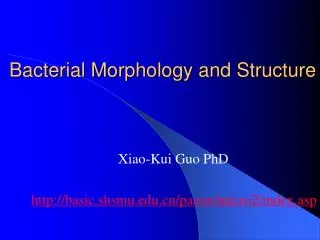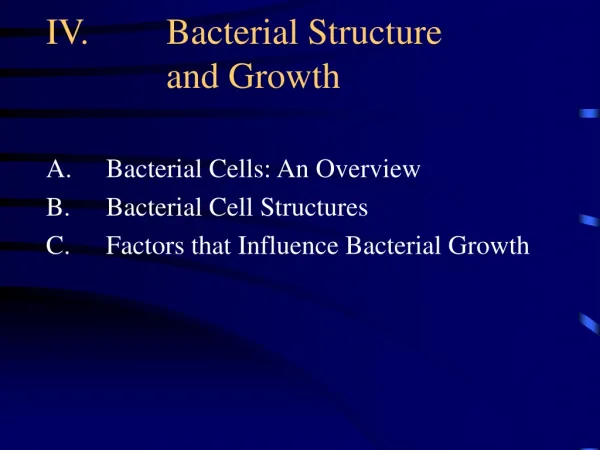Bacterial Structure
Bacterial Structure. Structure of Bacteria. All cells have 3 main components: DNA (‘nucleoid”) genetic instructions surrounding membrane (“cytoplasmic membrane”) limits access to the cell’s interior cytoplasm, between the DNA and the membrane where all metabolic reactions occur
Share Presentation
Embed Code
Link
Download Presentation
- transport
- glucose symport
- teichoic acid
- basic rule
- bacterial structure
- hydrophobic amino acids

Thomas + Follow
Download Presentation
Bacterial Structure
An Image/Link below is provided (as is) to download presentation Download Policy: Content on the Website is provided to you AS IS for your information and personal use and may not be sold / licensed / shared on other websites without getting consent from its author. Content is provided to you AS IS for your information and personal use only. Download presentation by click this link. While downloading, if for some reason you are not able to download a presentation, the publisher may have deleted the file from their server. During download, if you can't get a presentation, the file might be deleted by the publisher.
Presentation Transcript
- Bacterial Structure
- Structure of Bacteria • All cells have 3 main components: • DNA (‘nucleoid”) • genetic instructions • surrounding membrane (“cytoplasmic membrane”) • limits access to the cell’s interior • cytoplasm, between the DNA and the membrane • where all metabolic reactions occur • especially protein synthesis, which occurs on the ribosomes • Bacteria also often have these features: • cell wall • resists osmotic pressure • flagella • movement • pili • attachment • capsule • protection and biofilms
- Cell Envelope • The cell envelope is all the layers from the cell membrane outward, including the cell wall, the periplasmic space, the outer membrane, and the capsule. • All free-living bacteria have a cell wall • periplasmic space and outer membrane are found in Gram-negatives • the capsule is only found in some strains
- Cell Membrane • The cell membrane (often called the plasma membrane) is composed of 2 layers of phospholipids. • Phospholipids have polar heads and non-polar tails. • “Polar” implies that the heads are hydrophilic: they like to stay in an aqueous environment: facing the outside world and the inside of the cell. • “non-polar” means that the tails are hydrophobic: they want to be away from water, in an oily environment. The tails are in the center of the membrane • A pure phospholipid membrane only allows water, gasses, and a few small molecules to move freely through it.
- Membrane Proteins • Proteins float in the membrane like ships on the surface of the sea: the fluid-mosaic model. • Peripheral membrane proteins are bound to one surface of the membrane. • Some attached to the cell membrane by a fatty acid covalently attached to one of the protein’s amino acids • Others are attached by stretches of hydrophobic amino acids of the protein’s surface • Integral membrane proteins are embedded in the membrane by one or more stretches of hydrophobic amino acids. Many of these proteins transport molecules in and out of the cell. The transport proteins are very selective: each type of molecule needs its own transporter.
- Transport Across the Cell Membrane • Basic rule: things spontaneously move from high concentration to low concentration (downhill). This process is called diffusion. • Getting many molecules into the cell is simply a matter of opening up a protein channel of the proper size and shape. The molecules then move into the cell by diffusing down the concentration gradient. Passive transport, or facilitated diffusion. • To get things to move from low to high (uphill), you need to add energy: the molecules must be pumped into the cell. Pumps are driven by ATP energy. Active transport.
- More Membrane Transport • Often2 molecules are transported together, with one moving by diffusion down its concentration gradient and the other carried along up its concentration gradient. • If the two molecules move in the same direction, the protein channel is a symporter. See the diagram of the sodium-glucose symport mechanism • If the two molecules move in opposite directions, the channel is an antiporter.
- Cell Wall • Osmotic pressure is the force generated by water attempting to move into the cell. • Water can go through the cell membrane freely • The contents of the cell are very concentrated • Like all things, water moves from areas of high concentration to areas of low concentration. This means, water will move from outside the cell (dilute environment) to inside (concentrated environment). • Osmotic pressure can easily cause a cell to swell up and burst. • Bacteria, along with plants and fungi, resist osmotic pressure by surrounding the cell in a rigid box, the cell wall. • Composed of peptidoglycan (also called proteoglycan or murein) • Long chains of polysaccharide cross-linked by short peptides (amino acid chains). • The peptides contain the unusual mirror-image amino acids D-alanine and D-glutamate • polysaccharide is composed of alternating “amino sugars”: N-acetylglucosamine and N-acetylmuramic acid
- More Cell Wall • Gram-positive vs Gram-negative are defined by the structure of the cell wall • the Gram stain binds to peptidoglycan • Gram-positive: many layers of peptidoglycan, which is anchored to the cell membrane by teichoic acid. • Gram-negative: 1-2 layers of peptidoglycan = thin • The periplasmic space is between the cell membrane and the cell wall. It contains enzymes and other proteins, such as chemoreceptors for sensing the environment. • Outside the peptidglycan layer is the “outer membrane”. It is pierced by porins: protein channels, and its out surface is covered with lipopolysaccharides (sugars linked to membrane lipids), which are often antigenic and or toxic.
- Capsule Some bacteria (often pathogens) are surrounded by a thick polysaccharide capsule. This is a loose jelly-like or mucus-like layer. It helps prevent immune system cells from reaching the bacteria, and it forms part of biofilms.
- Membrane Structures • Pili (singular = pilus) are hairs projecting from the surface. They are composed of pilin protein. There are several types: • DNA can be transferred between bacteria by conjugation, which is initiated when sex pili on the donor cell attach to and draw in the recipient cell. • Fimbriae (singular = fimbria) are pili used to attach the bacteria to target cells ( in infection) or to surfaces, where they form a biofilm. • Flagella are long hairs used to propel the cells. They are composed of flagellin protein. • At the base of each flagellum is a motor embedded in the membrane and cell wall. It turns in a rotary motion, driven by proton-motive force (the flow of protons i.e. H+ ions across the cell membrane). • The suffix “-trichous” is used to describe the placement of flagella: e.g. lophotrichous = several flagella all clustered at one end.
- Chemotaxis • The flagellar motor is reversible: • Counterclockwise rotation: bacterium moves in a straight line • clockwise rotation: bacterium tumbles randomly • the motor periodically reverses, causing a random change in direction: bacteria move in a random walk. • chemotaxis: bacteria move toward the source of nutrients by swimming up the chemical gradient. Or, away from a toxin. • When moving up the gradient, bacteria rarely tumble, but when moving across it, or in the opposite direction, tumbling is frequent. • This produces a net motion in the proper direction
- Spores • Some bacteria can form very tough spores, which are metabolically inactive and can survive a long time under very harsh conditions. • Allegedly, some bacterial spores that were embedded in amber or salt deposits for 25 million years have been revived. These experiments are viewed skeptically by many scientists. • Panspermia: the idea that life got started on Earth due to bacterial spores that drifted in from another solar system. (However, it still had to start somewhere!). • “Extraordinary claims demand extraordinary proof” • Spores can also survive very high or low temperatures and high UV radiation for extended periods. This makes them difficult to kill during sterilization. • Anthrax • Spores are produced only by a few genera in the Firmicutes: • Bacillus species including anthracis (anthrax) and cereus (endotoxin causes ~5% of food poisoning) • Clostridium species including tetani (tetanus), perfringens (gangrene), and botulinum (botulism: food poisoning from improperly canned food)
 Bacterial Morphology and Structure" width="320px" />
Bacterial Morphology and Structure" width="320px" />
Bacterial Morphology and Structure Xiao-Kui Guo PhD http://basic.shsmu.edu.cn/passw/micro2/index.asp SIZE OF BACTERIA Unit for measurement : Micron or micrometer,μm: 1μm=10-3mm Size: Varies with kinds of bacteria, and also related to their age and external environment.
3.4k views • 21 slides

Bacterial Infections
Pathogens. Micro-organisms can produce a disease: BacteriaFungiVirusesOral mucosa is protected byIgA present in the saliva attacks bacteriaIgA forming complexs with epithelium acting as a protective coat of mucosaWashing effect of saliva. Pathogens. Pathogens can be transferred via:Air on dust particlesWater droplet.Hands
1.13k views • 20 slides

IV. Bacterial Structure and Growth
IV. Bacterial Structure and Growth. A. Bacterial Cells: An Overview B. Bacterial Cell Structures C. Factors that Influence Bacterial Growth. IV. A. Bacterial Cells: An Overview. Shapes & Arrangements Round Bacteria Coccus Staphylococcus Diplococcus Tetrad Streptococcus Sarcina
888 views • 38 slides



 Bacterial Morphology and Structure" width="320px" />
Bacterial Morphology and Structure" width="320px" />
